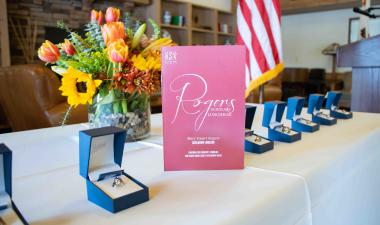George Floyd’s murder sent millions to the streets.
It sent Stanislaus State Art Professor Daniel Edwards to his computer.
There, he and his 21-year-old son, Rodman, sculpted a 3-dimensional bust of the man murdered in Minneapolis when a police officer knelt on his neck for a horrifying 8 minutes and 46 seconds, extinguishing his life and igniting a national movement.
The sculpture, based on a limited number of available photographs, was done in two days. Within four, at the suggestion of a friend, it was made available for free online for other artists supporting Black Lives Matter to use to create George Floyd memorials in their communities.
“Many in the 3D printing community are staying at home, social distancing, unable to join the protests, but wishing to show their support,” Daniel Edwards wrote on Sketchfab, a website dedicated to 3D, virtual reality and augmented reality where it was posted. “They can 3D print a memorial portrait of George Floyd at home, and post images of the bust for online vigils through social media.”
They also could 3D print the bust in any material, which is what Chris Carnabuci did, using wood for an installation in Brooklyn, New York, that was unveiled on Juneteenth of this year.
“He reached out to me about a year ago, and he threw me a little bit, because he was talking about monetizing it,” Edwards said.
That wasn’t something Edwards had anticipated, but he made peace with Carnabuci’s doing so. He was less forgiving about the New York-based artist’s failure to credit the Edwards team for their creation. Threats of withdrawing permission to use the bust prompted Carnabuci to finally credit the pair for the design.
Others may be using it without the Edwardses’ knowledge, because notification isn’t required. Sketchfab numbers show 1,300 downloads and 8,200 views.
One use that Daniel Edwards has seen is augmented reality, where someone converts a photo of the George Floyd bust into augmented reality, then walks around a fixed location, making it appear as though the sculpture is resting in place. One person used the process to photograph images of the bust all over his hometown of Portland, Oregon.
“I’d never seen that,” Edwards said. “That was amazing. That’s the direction I want to go. I’m a little behind there.”
It might be the first time he’s lagged in technology since he arrived at Stan State in 2012 to teach sculpture.
He’d already incorporated 3D sculpting in his work, and while initial steps had been taken to use the process at the University, the process became a true part of the discipline once the necessary printers were available and like-minded colleague Jake Weigel came aboard.
“Our assumption is the newer generation is well versed in computers and everything that has to do with them. That’s wrong,” Edwards said.
Students’ thumbs may fly while Edwards struggles to figure out texting, but Edwards and Weigel struggle to get students to follow them and the art world in computer-generated sculpture.
“We realized we had to integrate it into the curriculum,” Edwards said. “It has to be an assignment. I think it needs a very ambitious student using it and getting accolades for it.”
Or maybe having their professor and his son create a piece used for an installation on the other side of the country.
The Carnabuci piece was defaced within days of its Juneteenth unveiling. White supremacists threw black paint on the bust that rests atop a pedestal covered with phrases and quotations.
Rodman Edwards was upset by the defacing, his dad said, but was comforted by volunteers who worked to clean the piece.
Daniel Edwards, who was excited to see the bust unveiled on the first federal recognition of Juneteenth, took a slightly different view.
“When a sculpture gets vandalized, it shows the importance of sculpture,” Daniel Edwards said. “I have no objections when statues are torn down or vandalized as a form of expression. Just because we put it up doesn’t mean it’s going to stay there forever or that it’s always going to have the same meaning.”
Some hold up over time. A sculpture he helped create in Indianapolis — which commemorates the speech Robert Kennedy gave there the night Martin Luther King Jr. was assassinated, calming the city while others burst out in riots — is still standing. It was ranked the third Most Beautiful Civil Rights Monument in America by Architectural Digest.
It and the Floyd bust are among many that bring together Edwards’ artistry and social conscience. Busts of John Lewis, Sandra Bland, Ahmaud Arbery, Breonna Taylor and Colin Kaepernick are among those Edwards hopes can replace racist monuments being removed.
His worldview, formed in childhood by parents who became adults in the 1960s, hasn’t changed. Just his art.
Edwards trained as a sculptor at Heron School of Art at the University of Indiana, his home state, and New York Academy of Art, in traditional clay and wax. He began teaching those skills to his son when Rodman was 7, and they both embraced the new technology that fine artists, if not academic institutions, are regularly employing.
The same skills and deft work are required for each medium, Edwards said. The upside is digital work is more cost effective. Edwards said he can’t imagine ever having another mold in his possession. And computer programs have improved over time.
His job now is to convince students, comfortable with the clay they likely became familiar with in high school, to embrace technology that grips so much of the rest of their lives.
The possibilities, Edwards has shown, have no boundaries.


